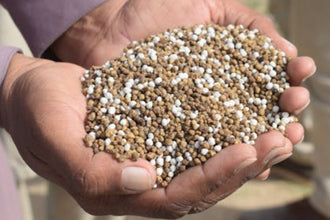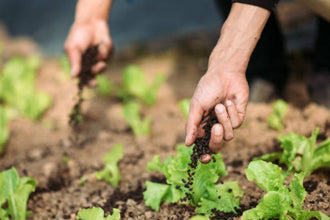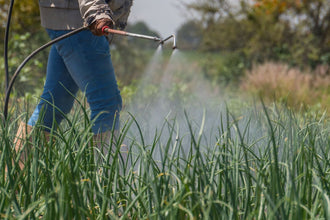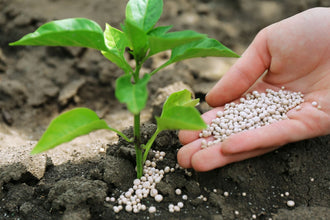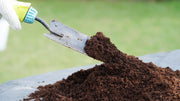
Getting your fertilizer frequency right can make or break your garden. You've probably seen neighbors with amazing gardens and wondered what they do differently. Most of the time, they just know when and how often to feed their plants.
Too many gardeners either dump fertilizer on everything or forget about it completely. Both approaches waste money and can hurt your plants. Each type of plant has its own eating schedule, just like people do. Your tomatoes need different meals than your roses.
Understanding What Your Plants Actually Need
Plants are picky eaters. Some gobble up nutrients fast while others take their sweet time. Fast-growing veggies like lettuce burn through food quickly during summer. Slow growers like trees can go months between meals.
Your soil plays a huge role in fertilizer frequency too. Sandy soil acts like a strainer - water and nutrients wash right through. Clay soil holds onto everything but releases it slowly. If you don't know your soil type, grab a handful when it's damp. Sandy soil falls apart. Clay soil sticks together like play dough.
Weather changes everything about how plants eat. Hot days make plants drink more water, which means they soak up more nutrients. Cool spring days slow everything down. Heavy rains wash nutrients away faster than you can say "mud puddle."
How to Tell When Plants Need Food
Your plants will tell you when they're hungry if you know what to look for. Yellow leaves starting at the bottom usually mean they need nitrogen. Think of it like the plant version of being hangry.
Purple edges on leaves often mean phosphorus problems. Brown tips can mean potassium shortage or that you've been overfeeding. Yes, plants can get overstuffed too.
Stunted growth without bugs or disease is another red flag. Pale green instead of rich, deep green means it's feeding time. Poor flowers or fruit despite good weather also points to fertilizer frequency issues.
Organic vs Synthetic: What's the Difference for Timing
Organic fertilizers work like a slow cooker. They release nutrients over weeks or months. This means fewer applications but you need to plan ahead. Synthetic fertilizers are like fast food - quick results but you need to reapply more often.
Organic options improve your soil while feeding plants. They feed the good bacteria and microbes that help plants absorb nutrients naturally. Over time, this creates a system that needs less frequent fertilizing.

Fertilizer Frequency for Your Vegetable Garden
Vegetables are the teenagers of the plant world. They're always hungry and growing fast. Most veggies need feeding every 4 to 6 weeks during growing season. Heavy eaters like tomatoes, corn, and squash might need food every 3 to 4 weeks.
Leafy greens grow so fast you can almost watch them. They need steady nitrogen to keep producing those tender leaves. Feed lettuce, spinach, and kale every 3 to 4 weeks with balanced fertilizer.
Root vegetables like carrots and beets are different. Too much nitrogen makes huge tops but tiny roots. Feed these guys once at planting and once midseason with phosphorus and potassium.
The Heavy Eaters in Your Garden
Some vegetables are just bottomless pits when it comes to nutrients. These plants produce tons of leaves, flowers, and fruit, so they need regular meals to keep going.
Tomatoes, Peppers, and Eggplants:
-
Start with good compost or balanced organic fertilizer in the soil
-
Feed every 3 to 4 weeks during growing season
-
Use balanced fertilizer throughout the season
Corn:
-
Feed at planting time
-
Apply nitrogen when plants reach knee height
-
Feed again when tassels appear
-
This timing matches when corn needs nutrients most
Squash, Pumpkins, and Melons:
-
Feed monthly during active growth
-
These vining crops produce lots of leaves and fruit
-
Need steady nutrients to keep producing
The Light Eaters That Don't Need Much
Some vegetables actually prefer to stay a little hungry. Overfeeding these plants can backfire and reduce quality or flavor.
Beans and Peas:
-
Fix their own nitrogen through special root bacteria
-
Only need balanced fertilizer at planting
-
Leave them alone unless soil test shows problems
Herbs:
-
Prefer lean soil conditions
-
Too much fertilizer reduces flavor and essential oils
-
Feed lightly 2 to 3 times during season with diluted fertilizer
Garlic and Onions:
-
Feed at planting time
-
Feed again in early spring when growth starts
-
These slow growers don't need frequent applications
Flower Fertilizer Frequency
Annual flowers are show-offs that bloom all season long. They need regular feeding to keep producing those colorful displays. Feed bedding plants every 4 to 6 weeks during growing season.
Perennial flowers work on a different schedule. Feed established perennials in early spring when you see new growth starting. Many benefit from a second feeding in midsummer to support late season blooms.
Bulbs are planning ahead for next year. Feed spring bulbs after they bloom but before the leaves die back. Fall-planted bulbs like a meal at planting time.
High-Maintenance Beauties
Some flowers demand royal treatment if you want spectacular results. These plants reward extra attention with amazing displays.
Roses:
-
Feed monthly during growing season
-
Use balanced organic fertilizer
-
Stop feeding 6 to 8 weeks before first frost
-
This helps them prepare for winter
Dahlias:
-
Need feeding every 3 to 4 weeks during active growth
-
High-phosphorus fertilizer supports better flowers
-
These massive blooms need lots of energy
Container Flowers:
-
Need more frequent feeding due to limited soil
-
Feed every 2 to 3 weeks with diluted liquid fertilizer
-
Or use slow-release granules at season start
Easy-Going Flowers That Don't Need Much
Some flowers actually perform better when you mostly ignore them. These low-maintenance options fit busy lifestyles perfectly.
Native Wildflowers:
-
Adapted to local soil conditions
-
Rarely need supplemental feeding
-
Over-fertilizing can make them susceptible to problems
Succulents and Drought-Tolerant Plants:
-
Apply diluted fertilizer 2 to 3 times during growing season
-
Store nutrients efficiently
-
Don't need frequent applications
Self-Seeding Annuals:
-
Calendula and cosmos often do better with minimal fertilizer
-
Rich soil can produce too many leaves and fewer flowers
Getting Your Lawn Fertilizer Frequency Right
Cool-season grasses like fescue and bluegrass eat differently than warm-season varieties. Cool-season lawns need spring and fall feeding when they grow most actively.
Warm-season grasses including Bermuda and Zoysia want summer meals when they're actively growing. These grasses sleep through winter and don't need food during dormant periods.
Most established lawns only need fertilizer 2 to 4 times per year. New lawns might need more frequent feeding during the first year to get established.
Seasonal Lawn Feeding Schedule
Spring Feeding:
-
Jumpstarts growth after winter
-
Apply when soil temperature hits 55 degrees consistently
-
Use balanced fertilizer
Summer Feeding:
-
Supports grass during heat stress
-
Use slow-release to avoid burning
-
Water thoroughly after applying
Fall Feeding:
-
Most important application for long-term health
-
Helps grass store nutrients for winter
-
Supports early spring growth
Tree and Shrub Fertilizer Schedules
Established trees and shrubs are like wise old relatives. They don't need much fussing once they're settled in. Most woody plants only need annual feeding in early spring before new growth starts.
Young trees and shrubs are still growing up. They might need feeding 2 to 3 times during their first growing season to get established properly.
Fruit trees have their own special timing. Feed them in late winter before buds break. Some varieties like an extra meal after fruit sets.
Special Cases for Woody Plants
Evergreen Shrubs:
-
Rhododendrons and azaleas prefer acidic fertilizer in spring
-
Have shallow roots that benefit from organic mulch
-
Need gentle feeding
Deciduous Shrubs:
-
Those that bloom on old wood get fertilizer after flowering
-
This timing supports next year's flower buds
-
Don't feed too late in season
Large Shade Trees:
-
Rarely need supplemental fertilizer once established
-
Focus on mulching and soil health instead
-
Save your money for other garden areas
Timing Fertilizer with the Seasons
Spring is like New Year's for plants. Soil warms up and roots start working again. This is prime time for the first fertilizer application of the year.
Summer feeding keeps plants going during peak growing season. Hot weather speeds up nutrient uptake but also increases burn risk. Apply fertilizer in early morning or evening during summer.
Fall feeding gets plants ready for winter and supports early spring growth. Stop feeding 6 to 8 weeks before expected frost so plants can toughen up for cold weather.
Winter is nap time for most plants. They won't use nutrients efficiently during dormancy. Focus on improving soil during winter months instead.
Container Plants Need Extra Attention
Container plants are like pets - they depend on you for everything. Limited soil means nutrients wash away faster through drainage holes. Most container plants need feeding every 2 to 3 weeks during growing season.
Use diluted liquid fertilizer for quick results or add slow-release granules when you plant. Large containers hold more soil and nutrients, so they need less frequent feeding. Small pots need more attention.
Indoor plants grow slower than outdoor containers. Feed monthly during growing season and less often in winter when growth slows down.
Give Your Garden the Feeding Schedule It Deserves
Smart fertilizer frequency creates stronger plants that fight off pests and diseases naturally. Start by getting your soil tested to understand what you're working with. Then create a feeding schedule based on what you're actually growing.
Regular, moderate feeding beats occasional heavy meals every time. Your plants will reward you with healthy growth, beautiful flowers, and great harvests when you match their feeding needs to how they naturally grow. Stop guessing and start feeding your garden the right way.




